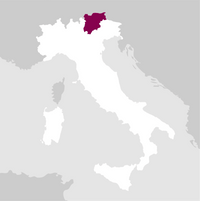Description
The Pinot Grigio has been grown in Trentino for decades. Now converted to organic production, the foothill and valley vineyards of Lavis and Gardolo, with their sandy loam soils of Avisio river deposits and alluvial sediments from the Adige, provide the perfect growing environment for Pinot Grigio.
Details

Perfume

Color

Taste
Serve at:
10 - 12 °C.
Longevity:
03 - 05 years

Pairings
- Start up year: 1948
- Oenologist: Ezio Dallagiacoma, Marco Sartori
- Bottles produced: 2.000.000
- Hectares: 400
The logo takes inspiration from a decorative element that has always been present in the company and bears a highly symbolic value: a wooden bas-relief celebrating the founding of the winery in 1948 which represents the coats of arms of the municipalities of Lavis, Giovo and Meano, the very first protagonists in the association’s establishment. A timeless brand of great strength that puts the Winery and its founding values at the centre: cooperation, history and the bond with the territory.
The Lavis wine-makers cooperative traces its origins to 1850, when the Cembran family built the initial core of the current production unit. It was officially formed in 1948 by 14 independent wine-makers and grew in the years that followed, due partly to acquisitions of other producers, including mergers with the Salorno Cooperative of South Tyrol in 1969 and Cantina Sociale di Cembra in 2003. Read more


| Name | La Vis Pinot Grigio Trentino 2023 |
|---|---|
| Type | White still |
| Denomination | Trentino DOC |
| Vintage | 2023 |
| Size | 0,75 l |
| Alcohol content | 13.0% by volume |
| Grape varieties | 100% Pinot Grigio |
| Country | Italy |
| Region | Trentino Alto Adige |
| Vendor | La Vis |
| Origin | Towns of Lavis and Trento. |
| Climate | Altitude: 270 m. a.s.l. Exposure: West, South-West. |
| Soil composition | Loose sandy loam, moderately stony, formed of fluvial and alluvial deposits. |
| Cultivation system | Guyot and trellised "pergola" system. |
| Plants per hectare | 4,500. |
| Harvest | By hand, the second decade of September. |
| Wine making | Soft pressing, static decantation of the must, and fermentation in stainless steel tanks at controlled temperatures. |
| Aging | On the lees for about 5/6 months before bottling. |
| Allergens | Contains sulphites |





